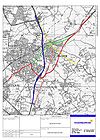OS Map Symbols/Road Structures
Showing roads on maps is not just about what type of road you are looking at, but also about how a road interacts with the landscape, whether natural or man-made. As such, there are a range of structures and other features which are found on roads, the following being commonly shown on OS maps. Many of these symbols remain unchanged from the first colour one inch series.
Bridges
Perhaps the most common structure on the road network is a bridge. Whether it is where a road crosses a river, or a railway crosses a road, the same basic symbol has been used since coloured maps first appeared. Prior to that, it appears that one symbol was laid on top of the other, which if truth be told, is generally sufficient to identify what it happening.
For around a century, however, maps have shown bridges by adding two additional lines, one either side of the feature (road, rail or other) on the bridge. These are flared at the ends, either producing a right angle or giving a suggestion of the shape of the abutments. Indeed, where two features cross at a severe skew, these lines can run parallel to the feature running under the bridge. As a generic symbol on the key, however, a 135 degree angle is normally shown at each end.
Viaducts
Where a road crosses a viaduct, a different symbol is used. This appears to have originated with the railways, but with modern dual carriageways and motorways, the symbol has been transferred. Here, the ends of the viaduct section are shown as per the bridge, but additional triangular bumps, suggesting piers, are added along the length of the viaduct. The symbol is often omitted in urban areas, and seems not to be used on 1:25,000 maps.
Tunnels
Tunnel mouths are shown with a curved arc, similar in principle to the bridge symbol. The road is then indicated within the tunnel by the black bounding lines continuing as dashed lines without colour.
Cuttings and embankments
The steep slopes created by constructing cuttings and embankments are shown with black 'saw tooth' symbols, the wider end of the teeth being at the top of the slope. Cuttings have the additional feature of a continuous black bounding line along the crest of the slope.
Gates and Cattle Grids
Gates across roads, whilst very rare these days, are still shown by a solid black bar across the road, sometimes the word 'Gate' is also printed for added clarity. Sometimes this symbol is difficult to differentiate from a spot height, although the two are rarely shown in close proximity.
Cattle grids are rarely, if ever shown on one inch or Landranger maps. However, explorer maps tend to show the, although it cannot be guaranteed that they are comprehensively included. They are often marked with a gate symbol, and a 'CG' or 'Cattle Grid' text adjacent. However, in some locations only the text is included, the assumption being that the fenclines will identify the location.
Tolls
Although thankfully rare on British Roads, Tolls are shown in a similar manner to gates, with black lines across the road, and the road 'Toll' nearby. However, on 1:25,000 mapping, a building is depicted as sitting on the road, to show the actual structure of the toll plaza.
Level Crossings
Where a road crosses a railway on the level, a range of symbols are used on OS maps. Considering the dangerous natures of these points of the network, it is perhaps surprising that a uniform symbol has never been adopted. Early maps are very unclear in their depiction of level crossings, simply showing the railway symbol crossing the road, but this is hardly different to the way bridges are shown. The early coloured maps are hardly any better, but the 7th series are clearer, with both the road and railway narrowing to a point for the crossing. Landranger maps have reverted to the early symbol, but with the addition of 'LC' nearby to identify the level crossing. Explorer maps are the same, although normally without 'LC'. Smaller scale OS maps are much clearer, with a red cross across the level crossing.
| OS Mapping | ||||||||
| ||||||||
|




